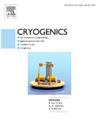航天仪器用低温无振动制冷机的研究进展
IF 2.1
3区 工程技术
Q3 PHYSICS, APPLIED
引用次数: 0
摘要
未来配备红外探测器的天体物理任务可能需要在低至4 K的温度下进行机械冷却。用于这些任务的候选机械冷却器需要以高热效率提供几乎持续的冷却,而不会通过振动发射干扰探测器。很少有4 K的机械制冷机可用于航天飞行。现有的冷却器效率低,通常需要额外的减振系统。本文介绍了反布雷顿制冷机和下级膨胀机低温冷却技术的研究进展。最近的进展包括已知的最低运行温度为4.9 K的含气涡轮发动机。此外,案例研究回顾了两种制冷机设计的性能,包括反向布雷顿循环和混合模式,在下部使用焦耳-汤姆逊膨胀器。每个制冷机在75 K时提供3w, 15 K时提供1w, 4.5 K时提供100mw。这两种冷却器都比任何现有的4 K冷却器效率高得多,并且混合设计具有极低振动发射的额外优势,在冷冻冷却器的冷端接近0.01 mN-rms。本文章由计算机程序翻译,如有差异,请以英文原文为准。
Progress on low temperature, vibration-free cryocoolers for space instruments☆
Future astrophysics missions equipped with infrared detectors are likely to require mechanical cooling at temperatures as low as 4 K. Candidate mechanical coolers for these missions need to deliver nearly constant cooling at a high thermal efficiency without disrupting the detector through vibration emissions. Very few 4 K mechanical cryocoolers are available for spaceflight. Available coolers demonstrate low efficiency and often require additional vibration reduction systems. This paper describes progress on low temperature cooling technology for Reverse Brayton Cryocoolers and lower stage expanders. Recent advancements include the lowest known operation of a gas bearing turbomachine at 4.9 K. Additionally, a case study reviews the performance of two cryocooler designs including Reverse Brayton Cycle and a hybrid model that uses a Joule Thomson expander at the lower stage. Each cryocooler provides 3 W at 75 K, 1 W at 15 K, and 100 mW at 4.5 K. Both coolers are much more efficient than any available 4 K coolers, and the hybrid design has the additional advantage of extremely low vibration emission, near 0.01 mN–rms at the cold end of the cryocooler.
求助全文
通过发布文献求助,成功后即可免费获取论文全文。
去求助
来源期刊

Cryogenics
物理-热力学
CiteScore
3.80
自引率
9.50%
发文量
0
审稿时长
2.1 months
期刊介绍:
Cryogenics is the world''s leading journal focusing on all aspects of cryoengineering and cryogenics. Papers published in Cryogenics cover a wide variety of subjects in low temperature engineering and research. Among the areas covered are:
- Applications of superconductivity: magnets, electronics, devices
- Superconductors and their properties
- Properties of materials: metals, alloys, composites, polymers, insulations
- New applications of cryogenic technology to processes, devices, machinery
- Refrigeration and liquefaction technology
- Thermodynamics
- Fluid properties and fluid mechanics
- Heat transfer
- Thermometry and measurement science
- Cryogenics in medicine
- Cryoelectronics
 求助内容:
求助内容: 应助结果提醒方式:
应助结果提醒方式:


